Failure Mechanisms and Protection Measures for Expansive Soil Slopes: A Review
Abstract
:1. Introduction
2. Mechanical and Hydraulic Properties of Unsaturated Soils
2.1. Effective Stress Principle and Shear Strength Theory
2.2. Soil–Water Characteristic Curve and Permeability Function
3. Failure Mechanisms of Expansive Soil Slopes
3.1. Field Test
3.2. Model Test
3.3. Numerical Simulation
4. Protective Measures for Expansive Soil Slope Failures
4.1. Waterproofing and Water Blocking
4.2. Limitation of Swelling–Shrinkage Deformation
4.3. Crack Inhibition and Strength Enhancement
4.3.1. Material Modification Method
4.3.2. Biological Modification Method
5. Discussion and Prospects of Expansive Soil Slope Research
5.1. Study of Slope Failure Mechanism
5.2. Research Direction for Slope Failure Mechanism
5.3. Protection Measures for Expansive Soil Slopes
5.4. Development Trends of Protection Methods for Expansive Soil Slopes
6. Conclusions
- (1)
- The failure mechanism of expansive soil slopes is complex. Repeated wet–dry cycles cause expansion and contraction deformation of the expansive soil, leading to cracking and strength reduction of the soil. Then, the rainwater infiltrates along the cracks under rainfall conditions, resulting in expansion and softening of the soil, increase of pore water pressure, and further reduction of soil strength. Simultaneously, rainwater infiltration generates seepage force, decreasing the slope safety coefficient. The expansive soil slope will experience a step-by-step retrogressive tractive shallow landslide when the downward sliding force exceeds the slip resistance force. The failure of expansive soil slopes is closely related to changes in soil moisture.
- (2)
- Obtaining the real strength of expansive soil is crucial to ensure the accuracy of slope stability studies. Meanwhile, numerical simulation should consider the influence of multiple factors and their coupling effects and analyze them in combination with model and field tests to obtain a more realistic slope failure mechanism. Notably, factors such as cracks, expansion forces, matrix suction, and soil softening should not be ignored in numerical simulations.
- (3)
- Three slope protection principles are proposed, including waterproofing and water blocking, swelling–shrinkage deformation limitation, and crack inhibition and strength enhancement. Nevertheless, there are still some shortcomings in slope protection based on these three principles, such as the impact on the ecological environment, the construction’s complexity, and the material’s durability and resistance. Additionally, the existing protection methods cannot simultaneously achieve effective anti-infiltration, anti-evaporation, and anti-scouring effects.
- (4)
- At present, few studies are related to protecting expansive soil slopes under complex scenarios such as long-term wet–dry and freeze–thaw cycles. The effectiveness of protective structures or materials in complex environments deserves further study. The failure mechanism of expansive soil slopes under complex environments will also be the focus of future research.
- (5)
- A novel flexible ecological protection system based on polymer waterproof coating with a double waterproofing layer can be considered to protect expansive soil slopes, which can reduce infiltration and evaporation and inhibit the cracking of slopes while being environmentally friendly. Low-carbon environmental protection, being environmentally friendly, and anti-seepage and moisturizing are vital points to be considered in future slope protection work and development trends. Finally, the combination of intelligent monitoring, early warning systems, and expansion soil slope protection is a critical research direction.
Author Contributions
Funding
Data Availability Statement
Conflicts of Interest
References
- Shi, B.; Jiang, H.; Liu, Z.; Fang, H.Y. Engineering geological characteristics of expansive soils in China. Eng. Geol. 2002, 67, 63–71. [Google Scholar] [CrossRef]
- Jones, L.D.; Jefferson, I. Expansive Soils; Institute of Civil Engineers Publishing: London, UK, 2012. [Google Scholar]
- Zheng, J.L.; Yang, H.P. Theory and Practice of Expansive Soil Treatment Technology; China Communications Press: Beijing, China, 2004. [Google Scholar]
- Puppala, A.J.; Cerato, A. Heave distress problems in chemically-treated sulfate-laden materials. Geo-Strata 2009, 10, 28–32. [Google Scholar]
- Liao, S.W. Expansive Soil and Railway Engineering; China Railway Publishing House: Beijing, China, 1984. [Google Scholar]
- Yang, H.P.; Zhang, G.F.; Zheng, J.L.; Zhao, P.C.; He, Y.X. Physical treating techniques of highway embankments filled with expansive soils. Chin. J. Geotech. Eng. 2009, 31, 491–500. [Google Scholar]
- Congress, S.S.C.; Puppala, A.J. Evaluation of UAV–CRP data for monitoring transportation infrastructure constructed over expansive soils. Indian Geotech. J. 2020, 50, 159–171. [Google Scholar] [CrossRef]
- Nobahar, M.; Khan, M.S.; Ivoke, J. Combined effect of rainfall and shear strength on the stability of highway embankments made of Yazoo clay in Mississippi. Geotech. Geol. Eng. 2020, 38, 2787–2802. [Google Scholar] [CrossRef]
- George, A.M.; Chahraborty, S.; Das, J.T.; Pedarla, A.; Puppala, A.J. Understanding shallow slope failures on expansive soil embankments in north Texas using unsaturated soil property framework. In Proceedings of the Second Pan-American Conference on Unsaturated Soils, Dallas, TX, USA, 12–15 November 2017; ASCE: Reston, VA, USA, 2018; pp. 206–216. [Google Scholar] [CrossRef]
- Khan, M.S.; Nobaha, M.; Ivoke, J.; Amini, F. Rainfall induced shallow slope failure over Yazoo clay in Mississippi. In Proceedings of the Second Pan-American Conference on Unsaturated Soils, Dallas, TX, USA, 12–15 November 2017; ASCE: Reston, VA, USA, 2017; pp. 153–162. [Google Scholar] [CrossRef]
- Tang, C.S.; Shi, B. Swelling and shrinkage behaviour of expansive soil during wetting-drying cycles. Chin. J. Geotech. Eng. 2011, 33, 1376–1384. [Google Scholar]
- Tan, L.R. Effect of lattice expansion and contraction of montmorillonite on its volume change. Hydroge Eng. Geol. 1981, 5–7. [Google Scholar]
- Chen, L.; Lu, L. Investigation on the characteristics of volumetric change during the wet-dry cycle of the soil. Chin. J. Undergr. Space Eng. 2013, 9, 229–235. [Google Scholar]
- Das, B.M. Advanced Soil Mechanics; CRC Press: London, UK, 2013. [Google Scholar]
- Puppala, A.J.; Manosuthikij, T.; Chittoori, B.C.S. Swell and shrinkage characterizations of unsaturated expansive clays from Texas. Eng. Geol. 2013, 164, 187–194. [Google Scholar] [CrossRef]
- Bao, C.G. Behavior of unsaturated soil and stability of expansive soil slope. Chin. J. Geotech. Eng. 2004, 26, 1–15. [Google Scholar]
- Li, Z.X.; Wang, X.C.; Chen, Y.Z.; Mao, Y. Strength and mechanic property of expansive soil. J. Traffic Transp. Eng. 2008, 8, 54–60. [Google Scholar]
- Gao, H.D.; An, R.; Zhang, X.W.; Wang, G.; Liu, X.Y.; Xu, Y.Q. Dynamic evolution of desiccation cracks and their relationship with the hydraulic properties of expansive soil. Int. J. Geomech. 2024, 24, 04023299. [Google Scholar] [CrossRef]
- Leng, T.; Tang, C.S.; Xu, D.; Li, Y.S.; Zhang, Y.; Wang, K.; Shi, B. Advance on the engineering geological characteristics of expansive soil. J. Eng. Geol. 2018, 26, 112–128. [Google Scholar] [CrossRef]
- Zhao, X.; Yang, Y.H.; Zhu, Y.J.; Zhang, J.P.; Ma, B. Analysis of impact of crack surface on shear strength of strong expansive soil. Rock Soil Mech. 2014, 35, 130–133. [Google Scholar] [CrossRef]
- Li, X.M.; Kong, L.W.; Guo, A.G.; Zhou, H.; Zhu, M.H. Effects of overconsolidation ratio and stress rate on unloading mechanical behavior of expansive clay. Rock Soil Mech. 2013, 34, 121–127. [Google Scholar] [CrossRef]
- Bao, C.G. On slope stability of expansive soil canal of Middle Route Project of S-N Water Transfer and countermeasures. Yangtze River 2003, 34, 4–6. [Google Scholar] [CrossRef]
- Zhan, L.T.; Ng, C.W.W.; Bao, C.G.; Gong, B.W. Artificial rainfall infiltration tests on a well-instrumented unsaturated expansive soil slope. Rock Soil Mech. 2003, 24, 151–158. [Google Scholar] [CrossRef]
- Xu, G.M.; Wang, G.L.; Gu, X.W.; Zeng, Y.J. Centrifuge modeling for instability of excavated slope in expansive soil due to water infiltration. Chin. J. Geotech. Eng. 2006, 28, 270–273. [Google Scholar]
- Gong, B.W.; Li, Q.Y.; Wen, S.L. Mechanics for unsaturated soils and its application in the south-to-north water transfer project. South-to-North Water Transf. Water Sci. Technol. 2008, 6, 143–147. [Google Scholar] [CrossRef]
- Huang, Z.; Shi, H.; Zhang, W.; Ma, S.; Gao, F.; Ma, M. Expansive Soil Embankment Filling and Cutting Treatment Technology: A Systematic Review. Adv. Mater. Sci. Eng. 2022, 2022, 4045620. [Google Scholar] [CrossRef]
- Yang, H.P.; Zheng, J.L.; Zhang, R. Addressing expansive soils. Civ. Eng. Mag. Arch. 2007, 77, 62–69. [Google Scholar] [CrossRef]
- Yang, H.P.; Zhao, P.C.; Zheng, J.L. Research on classified index system of expansive soils used as subgrade filler. Chin. J. Geotech. Eng. 2009, 31, 194–202. [Google Scholar]
- Terzaghi, K. The shearing resistance of saturated soils and the angle between the planes of shear. In Proceedings of the First International Conference on Soil Mechanics and Foundation Engineering, Cambridge, MA, USA, 22–26 June 1936; Volume 1, pp. 54–59. [Google Scholar]
- Bishop, A.W. The principle of effective stress. Tek. Ukebl. 1959, 106, 859–863. [Google Scholar]
- Fredlund, D.G.; Rahardjo, H. Soil Mechanics for Unsaturated Soils; John Wiley & Sons: New York, NY, USA, 1993. [Google Scholar]
- Bishop, A.W.; Blight, G.E. Some aspects of effective stress in saturated and partly saturated soils. Geotechnique 1963, 13, 177–197. [Google Scholar] [CrossRef]
- Fredlund, D.G.; Morgenstern, N.R.; Widger, R.A. The shear strength of unsaturated soils. Can. Geotech. J. 1978, 15, 313–321. [Google Scholar] [CrossRef]
- Zhang, C.G.; Zhao, J.H.; Zhu, Q. Classification and summary of shear strength formulae for unsaturated soils. J. Archit. Civ. Eng. 2012, 29, 74–82. [Google Scholar]
- Yang, H.Q.; Zhang, L.L. Bayesian back analysis of unsaturated hydraulic parameters for rainfall induced slope failure: A review. Earth-Sci. Rev. 2024, 251, 104714. [Google Scholar] [CrossRef]
- Van Genuchten, M.T. A closed-form equation for predicting the hydraulic conductivity of unsaturated soils. Soil Sci Soc. Am. J. 1980, 44, 892–898. [Google Scholar] [CrossRef]
- Shi, B.X.; Chen, S.S.; Han, H.Q.; Wang, T.B. Failure law of the expansive soil slope considering the suction changes. J. Hydraul. Eng. 2014, 45, 1499–1506. [Google Scholar] [CrossRef]
- Wang, M.W.; Yang, J.F.; Li, J.; Qin, S. Soil-water characteristics of undisturbed and unsaturated expansive clays in the xinqiao international airport area of hefei. Ind. Constr. 2012, 42, 41–45. [Google Scholar] [CrossRef]
- He, F.C.; Zhang, J.R. Water retention behavior and pore structure analysis of undisturbed expansive soil during drying and wetting. J. Basic Sci. Eng. 2022, 30, 736–747. [Google Scholar] [CrossRef]
- Zhang, R.; Zheng, J.L.; Ng, C.W.W. Experimental study on stress-dependent soil water characteristic curve of a recompacted expansive soil. Appl. Mech. Mater. 2013, 256–259, 283–286. [Google Scholar] [CrossRef]
- Al-Mahbashi, A.M.; Elkady, T.Y.; Al-Shamrani, M.A. Hysteresis soil-water characteristic curves of highly expansive clay. Eur. J. Environ. Civ. Eng. 2018, 22, 1041–1059. [Google Scholar] [CrossRef]
- Lin, B.; Cerato, A.B. Hysteretic soil water characteristics and cyclic swell–shrink paths of compacted expansive soils. Bull. Eng. Geol. Environ. 2013, 72, 61–70. [Google Scholar] [CrossRef]
- Jayanth, S.; Kannan, I.; Singh, D.N. Influence of drying and wetting cycles on swccs of fine-grained soils. J. Test. Eval. 2012, 40, 376–386. [Google Scholar] [CrossRef]
- Al-Mahbashi, A.M.; Elkady, T.; Al-Shamrani, M. The role of stress states on the hysteric behavior of expansive soil under multiple drying-wetting cycles. Buildings 2023, 13, 1619. [Google Scholar] [CrossRef]
- Goh, S.G.; Rahardjo, H.; Leong, E.C. Shear strength of unsaturated soils under multiple drying-wetting cycles. J. Geotech. Geoenviron. 2014, 140, 06013001. [Google Scholar] [CrossRef]
- Gong, B.W.; Ng, C.W.W.; Wang, B. Influence of stress states on soil-water characteristics of expansive soils. Rock Soil Mech. 2004, 25, 1915–1918. [Google Scholar] [CrossRef]
- Chen, T.L.; Zhou, C.; Wang, G.L.; Liu, E.L.; Dai, F. Centrifuge model test on unsaturated expansive soil slopes with cyclic wetting–drying and inundation at the slope toe. Int. J. Civ. Eng. 2018, 16, 1341–1360. [Google Scholar] [CrossRef]
- Cheng, Y.H.; Cheng, Z.L.; Zhang, Y.B. Centrifugal model tests on expansive soil slope under rainfall. Chin. J. Geotech. Eng. 2011, 33, 409–414. [Google Scholar]
- Chen, S.S.; Zheng, C.F.; Wang, G.L. Researches on long-term strength deformation characteristics and stability of expansive soil slopes. Chin. J. Geotech. Eng. 2007, 29, 795–799. [Google Scholar]
- Li, Z.H.; Cheng, Q.G.; Wang, Y.T.; Wang, X.F.; Lan, K.W.; Guo, Q. A centrifugal model test study of lime-improved expansive soil under drying and wetting circles. Hydroge Eng. Geol. 2017, 44, 111–117. [Google Scholar] [CrossRef]
- Cai, Z.Y.; Zhu, X.; Zhang, C.; Huang, Y.H. Performance evolution of expansive soil canal slope in high cold region. J. Cent. South Univ. (Sci. Technol.) 2022, 53, 21–50. [Google Scholar]
- Yang, W.Q.; Zhou, C.; Wang, L.; Li, H.M. Stability analysis of an expansive soil slope under rainfall using the thrust line method. J. Disaster Prev. Mitig. Eng. 2018, 38, 874–880. [Google Scholar] [CrossRef]
- Cheng, Z.; Ding, J.; Rao, X.; Cheng, Y.; Xu, H. Physical model tests of expansive soil slope. In Proceedings of the Geo-Congress, San Diego, CA, USA, 3–7 March 2013; pp. 731–740. [Google Scholar] [CrossRef]
- Khan, S.; Ivoke, J.; Nobahar, M. Coupled effect of wet-dry cycles and rainfall on highway slope made of Yazoo clay. Geosciences 2019, 9, 341. [Google Scholar] [CrossRef]
- Liu, S.; Cai, G.; Jiang, P.; Zhou, A.; Xu, H.; Sun, K. Shallow sliding failure analysis of weakly expansive soil slope during wet-dry cycles. Soil. Mech. Found. Eng. 2022, 58, 445–452. [Google Scholar] [CrossRef]
- Liu, L.W.; Zheng, J.L.; Miao, W. Researches on Characteristics of Swell and Shrinking Active Zone of Expansive Soil and Failure Mechanism of Landslides. Chin. J. Geotech. Eng. 2008, 30, 28–33. [Google Scholar]
- Gong, B.W.; Cheng, Z.L.; Hu, B.; Zhao, L. Research on engineering properties of fissures in expansive soil. Rock Soil Mech. 2014, 35, 1825–1830. [Google Scholar] [CrossRef]
- Ren, J.L.; Xiong, Y.; Cheng, Y.H.; Hu, S.G.; Hu, B. Stability analysis of high expansive soil slopes based on in-situ monitoring and model tests. Chin. J. Geotech. Eng. 2022, 44, 183–187. [Google Scholar]
- Li, Z.Y.; Xie, Q.; Kang, J.W.; Qu, M.F. Instability mechanism analysis of an expansive soil excavation slope in Chengdu. Build. Sci. 2015, 31, 8–12. [Google Scholar] [CrossRef]
- Li, X.W.; Kong, L.W.; Guo, A.G. Effects and correlation analysis of infiltration velocity of expansive soil cut slope. Rock Soil Mech. 2009, 30, 1291–1296. [Google Scholar] [CrossRef]
- Yu, Z.; Eminue, O.O.; Stirling, R.; Davie, C.; Glendinning, S. Desiccation cracking at field scale on a vegetated infrastructure embankment. Geotech. Lett. 2021, 11, 88–95. [Google Scholar] [CrossRef]
- Ng, C.W.W.; Zhan, L.T.; Bao, C.G.; Fredlund, D.G.; Gong, B.W. Performance of an unsaturated expansive soil slope subjected to artificial rainfall infiltration. Géotechnique 2003, 53, 143–157. [Google Scholar] [CrossRef]
- Hou, D.; Tao, Z.; Hao, Z.; Wang, J. Numerical analysis of rainfall saturated-unsaturated seepage and stability of expansive soil slope with fissures. In Proceedings of the International Conference on Structural, Mechanical and Material Engineering, Dalian, China, 6–8 November 2015; pp. 103–106. [Google Scholar] [CrossRef]
- Chen, J.B.; Kong, L.W.; Guo, A.G.; Zhao, Y.L.; Lv, H.B. Deformation characteristics of expansive soil slopes under precipitation and evaporation. China Civ. Eng. J. 2007, 40, 70–77. [Google Scholar]
- Pei, P.; Zhao, Y.; Ni, P.; Mei, G. A protective measure for expansive soil slopes based on moisture content control. Eng. Geol. 2020, 269, 105527. [Google Scholar] [CrossRef]
- Xie, C.; Ni, P.; Xu, M.; Me, G.; Zhao, Y. Combined measure of geometry optimization and vegetation for expansive soil slopes. Comput. Geotech. 2020, 123, 103588. [Google Scholar] [CrossRef]
- Wang, G.L.; Chen, S.S.; Xu, G.M. Centrifuge model test on stability of expansive soil slope under alternation between dry and wet. Hydro-Sci. Eng. 2005, 4, 6–10. [Google Scholar] [CrossRef]
- Rao, X.B.; Chen, Y.; Zeng, L. Centrifugal model test and FEM study on slope stability of expansive soil channel of water transfer project from south to north. J. Yangtze River Sci. Res. I 2002, 19, 105–107. [Google Scholar]
- Qin, L.S.; Zheng, J.L. Analysis of surficial failure mechanism of expansive soil slopes with FEM. China J. Highw. Transp. 2001, 14, 25–30. [Google Scholar] [CrossRef]
- Dai, Z.; Chen, S.; Li, J. Physical model test of seepage and deformation characteristics of shallow expansive soil slope. Bull. Eng. Geol. Environ. 2020, 79, 4063–4078. [Google Scholar] [CrossRef]
- Ma, S.K.; Ma, M.; Wei, R.K.; Hu, Y.; Shao, Y.; Huang, Z. Anti-infiltration and anti-scour characteristics of expansive soil slopes based on rubber polymer waterproof coating. J. Cent. South Univ. (Sci. Technol.) 2022, 53, 335–349. [Google Scholar]
- Li, X.W.; Dai, G.Z.; Yu, C.Y.; Wang, J.G. Stability analysis of cut slope of expansive soil based on fissure description. Chin. J. Geotech. Eng. 2013, 35, 1069–1075. Available online: www.cgejournal.com/cn/article/id/15069 (accessed on 8 May 2024).
- Zhan, T.L.T.; Ng, C.W.W.; Fredlund, D.G. Field study of rainfall infiltration into a grassed unsaturated expansive soil slope. Can. Geotech. J. 2007, 44, 392–408. [Google Scholar] [CrossRef]
- Zhang, H.; Yang, J.; Wang, L.; Xu, Y. Model test on the dynamic characteristics of crack formation in expansive soil slopes under alternate drying and wetting. Acta Geotech. 2023, 18, 2097–2115. [Google Scholar] [CrossRef]
- Zhai, J.Y.; Ma, M.J.; Hao, X.; Zhao, J.; Zhao, Y.; Yang, Q.Q. The indoor model test on the characteristic of expansive soil slope under climatic conditions. IOP Conf. Ser. Earth Environ. Sci. 2019, 304, 032056. [Google Scholar] [CrossRef]
- Xiao, J.; Yang, H.P.; Fu, H.; Tang, X.Y. Comparison model test on effect of geogrid reinforcement for expansive soil slope. China J. Highw. Transp. 2014, 27, 24–31. [Google Scholar] [CrossRef]
- Zhang, Y.B. Research of the Stability of Expansive Soil Slope Test on Centrifuge Model under Rainfall. Master’s Thesis, South China University of Technology, Guangzhou, China, 2011. [Google Scholar]
- Zhu, R.; Huang, Y.H.; Zhang, C.; Guo, W.L.; Chen, H. Laboratory and centrifugal model tests on failure mechanism of canal slopes under cyclic action of wetting–drying. Eur. J. Environ. Civ. Eng. 2022, 26, 2819–2833. [Google Scholar] [CrossRef]
- Ma, S.K.; Ma, M.; Huang, Z.; Hu, Y.; Shao, Y. Research on the improvement of rainfall infiltration behavior of expansive soil slope by the protection of polymer waterproof coating. Soils Found. 2023, 63, 101299. [Google Scholar] [CrossRef]
- Ma, S.K.; Ma, M.; Huang, Z.; He, B.F.; Hu, Y. Model test study on the protection of expansive soil slope with polymer waterproof coating. Geotext. Geomembr. 2023, 51, 125–136. [Google Scholar] [CrossRef]
- Amenuvor, A.C.; Li, G.W.; Wu, J.T.; Hou, Y.Z.; Chen, W.; Charkley, F.N. Crack development in a physical model of undisturbed expansive soil slope and core sample under wet-dry cycles. Eur. J. Environ. Civ. En. 2024, 28, 822–843. [Google Scholar] [CrossRef]
- Yang, Z.; Lv, J.; Shi, W.; Zhang, Q.; Lu, Z.; Zhang, Y.; Ling, X. Model test study on stability factors of expansive soil slopes with different initial slope ratios under freeze-thaw conditions. Appl. Sci. 2021, 11, 8480. [Google Scholar] [CrossRef]
- Li, Z.; Kong, Y.; Fu, L.; Zhou, Y.; Qian, Z.; Hu, R. Model test study on deformation characteristics of a fissured expansive soil slope subjected to loading and irrigation. Appl. Sci. 2021, 11, 10891. [Google Scholar] [CrossRef]
- Pipatpongsa, T.; Fang, K.; Leelasukseree, C.; Chaiwan, A.; Chanwiset, N. Reverse toe sliding criteria of laterally confined low wall slope subjected to counterweight fill. Int. J. Rock. Mech. Min. 2024, 175, 105683. [Google Scholar] [CrossRef]
- Zhang, J.M.; Zhou, Z.; Lin, F.; Yang, Q.G.; Luo, Y. Failure mechanism of a slow-moving landslide on September 27, 2020. in Chang Nong Village, Guangxi, China. Landslides 2021, 18, 2575–2592. [Google Scholar] [CrossRef]
- Liu, S.H.; Shen, C.M.; Cheng, D.H.; Zhang, C.B.; Mao, H.Y. Model test of expansive soil slope with soilbags during rainfall-insolation cycles. Rock Soil Mech. 2022, 43, 35–42. [Google Scholar] [CrossRef]
- Zhao, J.G.; Wang, J.D.; Gu, T.F.; Xia, M. Study on deformation characteristic and mechanism of expansive soil fill slope under precipitation-evaporation cycle. J. Nat. Disasters 2013, 22, 116–124. [Google Scholar] [CrossRef]
- Fan, Q.Y.; Liu, J.Q.; Yang, D.S.; Yuan, J.Q. Model test of expansive rock slope under different rainfall Patterns. Rock Soil Mech. 2016, 37, 3401–3409. [Google Scholar] [CrossRef]
- Qi, S.; Vanapalli, S.K. Hydro-mechanical coupling effect on surficial layer stability of unsaturated expansive soil slopes. Comput. Geotech. 2015, 70, 68–82. [Google Scholar] [CrossRef]
- Liang, C.; Wu, Z.; Liu, X.; Xiong, Z.; Li, T. Analysis of shallow landslide mechanism of expansive soil slope under rainfall: A case study. Arab. J. Geosci. 2021, 14, 584. [Google Scholar] [CrossRef]
- Rao, H.; Wang, J.S.; Zhao, Z.M.; Wu, G.; Feng, T. An analysis of rainfall infiltration of expansive soil slope based on the finite element software custom constitutive model. Hydroge Eng. Geol. 2021, 48, 154–162. [Google Scholar] [CrossRef]
- Yang, Q.; Li, R.; Zhang, S.; Li, R.; Bai, W.; Xiao, H. Algorithm implementation of equivalent expansive force in strength reduction fem and its application in the stability of expansive soil slope. Water 2022, 14, 1540. [Google Scholar] [CrossRef]
- You, Q.Y. Numerical simulation of the stability of added lime expansive soils embankment. Adv. Mater. Res. 2014, 838, 821–824. [Google Scholar] [CrossRef]
- Yuan, J.P.; Yin, Z.Z. Numerical model and simulation of expansive soils slope infiltration considered fissures. Rock Soil Mech. 2004, 25, 1581–1586. [Google Scholar] [CrossRef]
- Qi, S.; Vanapalli, S.K. Numerical study on expansive soil slope stability considering the cracks and coupling effects. In Proceedings of the 6th Asia-Pacific Conference on Unsaturated Soils, Guilin, China, 23–26 October 2015; pp. 621–628. [Google Scholar] [CrossRef]
- Yang, R.; Xiao, P.; Qi, S. Analysis of slope stability in unsaturated expansive soil: A case study. Front. Earth Sci. 2019, 7, 292. [Google Scholar] [CrossRef]
- Qi, S.; Vanapalli, S.K. Simulating the hydraulic and mechanical responses of an unsaturated expansive soil slope to rainfall: A case history. Int. J. Geomech. 2018, 18, 05018002. [Google Scholar] [CrossRef]
- Qi, S.; Vanapall, S.K.; Yang, X.G.; Zhou, J.W. Stability analysis of an unsaturated expansive soil slope subjected to rainfall infiltration. Geomech. Eng. 2019, 19, 1–9. [Google Scholar] [CrossRef]
- Zheng, C.F.; Chen, S.S.; Wang, G.L.; Han, H.Q. Numerical simulation of deformation process of expansive soil slopes due to dry-wet cycling. J. Hydraul. Eng. 2008, 39, 1360–1364. [Google Scholar]
- Qi, Y.; Wang, Z.; Xu, H.; Yuan, Z. Instability analysis of a low-angle low-expansive soil slope under seasonal wet-dry cycles and river-level variations. Adv. Civ. Eng. 2020, 2020, 3479575. [Google Scholar] [CrossRef]
- Ikeagwuani, C.C.; Nwonu, D.C. Influence of dilatancy behavior on the numerical modeling and prediction of slope stability of stabilized expansive soil slope. Arab. J. Sci. Eng. 2021, 46, 11387–11413. [Google Scholar] [CrossRef]
- Chen, X.; Jing, X.; Li, X.; Chen, J.; Ma, Q.; Liu, X. Slope crack propagation law and numerical simulation of expansive soil under wetting–drying cycles. Sustainability 2023, 15, 5655. [Google Scholar] [CrossRef]
- Jian, X.; Zha, X.; Zhan, H.; Yang, J. Research on the damaging mechanisms of expansive soil in subgrade. Mech. Adv. Mater. Struc. 2024, 31, 2362–2369. [Google Scholar] [CrossRef]
- Hou, D.; Zhou, Y.; Zheng, X. Seepage and stability analysis of fissured expansive soil slope under rainfall. Indian Geotech. J. 2023, 53, 180–195. [Google Scholar] [CrossRef]
- Liu, Y.; Li, F.; Chai, X.Q.; Du, X.W.; Zhang, H. Simplified stability analysis for expansive soil slope considering rainfall infiltration. Coal Geol. Explor. 2008, 36, 42–44. [Google Scholar]
- Yao, Y.; Li, J.; Xiao, Z.; Xiao, H. Soil-Water characteristics and creep deformation of unsaturated expansive subgrade soil: Experimental test and simulation. Front. Earth Sci. 2021, 9, 783273. [Google Scholar] [CrossRef]
- Guo, Z.; Zhao, Z. Numerical analysis of an expansive subgrade slope subjected to rainfall infiltration. Bull. Eng. Geol. Environ. 2021, 80, 5481–5491. [Google Scholar] [CrossRef]
- Lan, T.; Zhan, R.; Yang, B.; Meng, X. Influence of swelling on shear strength of expansive soil and slope stability. Front. Earth Sci. 2022, 10, 849046. [Google Scholar] [CrossRef]
- Boluk, B.; Chakraborty, S.; Puppala, A.J.; Jafari, N.H. Inverse analysis of a failed highway embankment slope in north texas. In Proceedings of the 4th International Conference on Transportation Geotechnics, Chicago, IL, USA, 23–26 May 2022; pp. 583–594. [Google Scholar] [CrossRef]
- Sun, H.; Hu, B.; Zhang, G.Q. Analysis of fissured expansive soil slope stability and its reinforcement with anti-slippery piles. Appl. Mech. Mater. 2013, 275, 1489–1492. [Google Scholar] [CrossRef]
- Zhao, S.; Shi, Z.; Peng, M.; Bao, Y. Stability analysis of expansive soil slope considering seepage softening and moistening expansion deformation. Water 2020, 12, 1678. [Google Scholar] [CrossRef]
- Liu, S.; Lu, Y.; Weng, L.; Bai, F. Field study of treatment for expansive soil/rock channel slope with soilbags. Geotext. Geomembr. 2015, 43, 283–292. [Google Scholar] [CrossRef]
- Liu, S.; Gao, C.; Fan, K.; Zhang, C.; Wang, Z.; Shen, C.; Han, Z. Repairing expansive soil channel slope with soilbags. Geosynth. Int. 2022, 30, 450–459. [Google Scholar] [CrossRef]
- Zhang, Y.H. Research on Stability Control Measures of Expansive Soil Slope. Master’s Thesis, Shijiazhuang Tiedao University, Shijiazhuang, China, 2022. [Google Scholar] [CrossRef]
- Liu, S.; Bai, F.; Wang, Y.; Wang, S.; Li, Z. Treatment for expansive soil channel slope with soilbags. J. Aerosp. Eng. 2013, 26, 657–666. [Google Scholar] [CrossRef]
- Xu, Y.F.; Huang, J. Case study on earth reinforcement using soilbags. In Geosynthetics in Civil and Environmental Engineering: Proceedings of the 4th Asian Regional Conference on Geosynthetics, Shanghai, China, 17–20 June 2009; Springer: Berlin/Heidelberg, Germany, 2009; pp. 597–602. [Google Scholar] [CrossRef]
- Rowe, R.K.; Bostwick, L.E.; Take, W.A. Effect of GCL properties on shrinkage when subjected to wet-dry cycles. J. Geotech. Geoenviron. 2011, 137, 1019–1027. [Google Scholar] [CrossRef]
- Zou, W.L.; Lin, J.G.; Han, Z.; Fan, K.W.; Pei, Q.Y.; Xu, Y.F. Progress on strengthening techniques for expansive soil slopes. J. Cent. South Univ. (Sci. Technol.) 2022, 53, 126–139. [Google Scholar]
- Xia, Y.; Liu, H.X.; Liu, J. The application of geomembrane combined with anti slide pile structure in soil slopes treatment and bridge foundation and protection in expansive soil area. Chin. J. Geotech. Eng. 2016, 38, 248–252. [Google Scholar]
- Hewitt, R.D.; Daniel, D.E. Hydraulic conductivity of geosynthetic clay liners after freeze-thaw. J. Geotech. Geoenviron. 1997, 123, 305–313. [Google Scholar] [CrossRef]
- Liu, X.Y.; Wu, Q.H.; Xu, L.; Zhuang, Y.F. A novel double-layer system for infiltration control and improvement in the stability of expansive soil slopes. Int. J. Geosynth. Groun. 2023, 9, 4. [Google Scholar] [CrossRef]
- Rahardjo, H.; Santoso, V.A.; Leong, E.C.; Ng, Y.S.; Hua, C.J. Performance of an instrumented slope covered by a capillary barrier system. J. Geotech. Geoenviron. 2012, 138, 481–490. [Google Scholar] [CrossRef]
- Harnas, F.R.; Rahardjo, H.; Leong, E.C.; Wang, J.Y. Experimental study on dual capillary barrier using recycled asphalt pavement materials. Can. Geotech. J. 2014, 51, 1165–1177. [Google Scholar] [CrossRef]
- Ng, C.W.W.; Coo, J.L.; Chen, Z.K.; Chen, R. Water infiltration into a new three-layer landfill cover system. J. Environ. Eng. 2016, 142, 04016007. [Google Scholar] [CrossRef]
- Ng, C.W.W.; Guo, H.W.; Xue, Q. A novel environmentally friendly vegetated three-layer landfill cover system using construction wastes but without a geomembrane. Indian Geotech. J. 2021, 51, 460–466. [Google Scholar] [CrossRef]
- Kong, L.W.; Chen, J.B.; Guo, A.G.; Zhao, Y.L.; Lv, H.B. Field response tests on expansive soil slopes under atmosphere. Chin. J. Geotech. Eng. 2007, 29, 1065–1073. [Google Scholar]
- Xiao, J.; Yang, H.P.; Zhang, J.H.; Tang, X.Y. Surficial failure of expansive soil cutting slope and its flexible support treatment technology. Adv. Civ. Eng. 2018, 2018, 1609608. [Google Scholar] [CrossRef]
- Xu, Q.; Fan, X.M.; Jiang, L.W.; Liu, P. Behavior of Expansive Soil Slope Reinforced with Geo-Grids; CRC Press: London, UK, 2008. [Google Scholar]
- Chen, G.Y.; He, P.; Wang, G.; Sun, S.Q.; Xiao, J. Shallow layer destruction law of expansive soil slope under rainfall and the application of geogrid reinforcement. Geofluids 2021, 2021, 6636894. [Google Scholar] [CrossRef]
- Lu, Z.F.; Yang, X.H.; Yan, C.G. Research on Cracking Mechanism of Expansive Soil Slope with Geo-cells Flexible Retaining Wall. Highway 2016, 61, 24–27. [Google Scholar]
- Xu, Y.; Su, C.; Huang, Z.; Yang, C.; Yang, Y. Research on the protection of expansive soil slopes under heavy rainfall by anchor-reinforced vegetation systems. Geotext. Geomembr. 2022, 50, 1147–1158. [Google Scholar] [CrossRef]
- Xu, Y.; Su, C.; Zhu, Q.; Yang, C.; Yang, Y. Field study of a new ecological slope protection method applied to expansive soil slope. Arab. J. Geosci. 2021, 14, 2871. [Google Scholar] [CrossRef]
- Tang, L.Q.; Chen, J.T.; Xu, Y.Z. Effects on atmospheric influence depth for an anchored vegetation reinforcement system to protect newly excavated expansive soil slopes. Bull. Soil. Water Conserv. 2022, 42, 145–152. [Google Scholar] [CrossRef]
- Xu, H.; Cheng, Z.L.; Huang, B.; Pan, J.J. The mechanism of inhibiting swelling deformation and slope instability of expansive soils by replacement method. Teh. Vjesn. 2014, 21, 1057–1063. [Google Scholar]
- Xu, H.; Huang, B.; Rao, X.B.; He, X.M. Study on rationality of treatment measures of expansive rock slope. South-to-North Water Transf. Water Sci. Technol. 2009, 12, 139–141. [Google Scholar]
- Lu, Z.; Tang, C.; Yao, H.; She, J.; Cheng, M.; Qiu, Y.; Zhao, Y. Model tests for the inhibition effects of cohesive non-swelling soil layer on expansive soil. Geomech. Eng. 2022, 29, 91. [Google Scholar] [CrossRef]
- Cheng, Y.; Xu, Y.; Wang, L.; Wang, L. Stability of expansive soil slopes reinforced with anchor cables based on rotational-translational mechanisms. Comput. Geotech. 2022, 146, 104747. [Google Scholar] [CrossRef]
- Zou, W.L.; Wang, X.Q.; Vanapalli, S.K. Experimental evaluation of engineering properties of GFRP screw anchors for anchoring applications. J. Mater. Civ. Eng. 2016, 28, 04016029. [Google Scholar] [CrossRef]
- Liu, Z.D.; Kong, G.R. Analysis on canal slope excavated in expansive soil by FEM. Eng. J. Wuhan. Univ. 1993, 26, 237–244. [Google Scholar]
- Zhang, R.; Liu, Z.; Zheng, J.; Zhang, J. Experimental evaluation of lateral swelling pressure of expansive soil fill behind a retaining wall. J. Mater. Civ. Eng. 2020, 32, 04019360. [Google Scholar] [CrossRef]
- Al-Juari, K.A.K.; Fattah, M.Y.; Khattab, S.I.A.; Al-Shamam, M.K. Simulation of behaviour of swelling soil supported by a retaining wall. In Proceedings of the Institution of Civil Engineers-Structures and Buildings; ICE: London, UK, 2022; pp. 293–302. [Google Scholar] [CrossRef]
- AbdelSalam, S.S.; Azzam, S.A. Reduction of lateral pressures on retaining walls using geofoam inclusion. Geosynth. Int. 2016, 23, 395–407. [Google Scholar] [CrossRef]
- Wang, L.J.; Liu, S.H.; Zhou, B. Experimental study on the inclusion of soilbags in retaining walls constructed in expansive soils. Geotext. Geomembr. 2015, 43, 89–96. [Google Scholar] [CrossRef]
- Manual, L. Lime-Treated Soil Construction Manual Lime Stabilization & Lime Modification; National Lime Association: Arlington, VA, USA, 2004. [Google Scholar]
- Bell, F.G. Lime stabilization of clay minerals and soils. Eng. Geol. 1996, 42, 223–237. [Google Scholar] [CrossRef]
- Al-Kiki, I.M.; Al-Atalla, M.A.; Al-Zubaydi, A.H. Long term strength and durability of clayey soil stabilized with lime. Eng. Technol. J. 2011, 29, 725–735. [Google Scholar]
- Cui, W.; Li, H.L.; Mu, N.M. Experimental research on engineering character of improved expansive soil with lime. Rock Soil Mech. 2003, 24, 606–609. [Google Scholar] [CrossRef]
- Cheng, T.; Gu, Q.K.; Guo, Y.C. Experiment on improve of expansive soil with lime. cement, ash. Highway 2008, 164–167. [Google Scholar]
- Kumar, B.R.P.; Sharma, R.S. Effect of fly ash on engineering properties of expansive soils. J. Geotech. Geoenviron. 2004, 130, 764–767. [Google Scholar] [CrossRef]
- Jain, A.K.; Jha, A.K. Shivanshi. Geotechnical behaviour and micro-analyses of expansive soil amended with marble dust. Soils Found. 2020, 60, 737–751. [Google Scholar] [CrossRef]
- Mohanty, S.K.; Pradhan, P.K.; Mohanty, C.R. Stabilization of expansive soil using industrial wastes. Geomech. Eng. 2017, 12, 111–125. [Google Scholar] [CrossRef]
- Mahedi, M.; Cetin, B.; White, D.J. Cement, lime, and fly ashes in stabilizing expansive soils: Performance evaluation and comparison. J. Mater. Civ. Eng. 2020, 32, 04020177. [Google Scholar] [CrossRef]
- Dong, Y.; He, W.Z.; Wang, B.T. Study on the impact of long-term immersion on the shear strength of compacted lime stabilized expansive soils. Appl Mech. Mater. 2012, 238, 431–434. [Google Scholar] [CrossRef]
- Rajasekaran, G. Sulphate attack and ettringite formation in the lime and cement stabilized marine clays. Ocean. Eng. 2005, 32, 1133–1159. [Google Scholar] [CrossRef]
- Khadka, S.D.; Jayawickrama, P.W.; Senadheera, S.; Segvic, B. Stabilization of highly expansive soils containing sulfate using metakaolin and fly ash based geopolymer modified with lime and gypsum. Transp. Geotech. 2020, 23, 100327. [Google Scholar] [CrossRef]
- Dang, L.C.; Khabbaz, H. A Practical application using industrial waste for enhancing the mechanical properties of expansive soil. In Proceedings of the 2nd Vietnam Symposium on Advances in Offshore Engineering, Ho Chi Minh City, Vietnam, 22–24 April 2021; pp. 80–88. [Google Scholar] [CrossRef]
- Dang, L.C.; Khabbaz, H.; Ni, B.J. Improving engineering characteristics of expansive soils using industry waste as a sustainable application for reuse of bagasse ash. Transp. Geotech. 2021, 31, 100637. [Google Scholar] [CrossRef]
- Malongweni, S.O.; Kihara, Y.; Sato, K.; Tokunari, T.; Sobuda, T.; Mrubata, K.; Masunaga, T. Impact of agricultural waste on the shrink–swell behavior and cracking dynamics of expansive soils. Int. J. Recycl. Org. 2019, 8, 339–349. [Google Scholar] [CrossRef]
- Villarreal, J.; Wang, F. Feasibility study on biochar-treated expansive soils. Int. J. Geosynth. Groun. 2021, 7, 27. [Google Scholar] [CrossRef]
- Khalid, U.; Ijaz, N.; Khan, I.; Junaid, M.F. Integrating wheat straw and silica fume as a balanced mechanical ameliorator for expansive soil: A novel agri-industrial waste solution. Environ. Sci. Pollut. R. 2023, 30, 73570–73589. [Google Scholar] [CrossRef]
- Babu, R.D.; Ramu, K.; Saandeepya, M.S. Performance evaluation of rice husk ash and phosphogypsum in stabilizing the problematic expansive soil. In Proceedings of the Indian Geotechnical Conference, Trichy, India, 16–18 December 2021; pp. 417–426. [Google Scholar] [CrossRef]
- Calik, U.; Sadoglu, E. Classification, shear strength, and durability of expansive clayey soil stabilized with lime and perlite. Nat. Hazards 2014, 71, 1289–1303. [Google Scholar] [CrossRef]
- Dang, L.C.; Khabbaz, H. Experimental investigation on the compaction and compressible properties of expansive soil reinforced with bagasse fibre and lime. In Proceedings of the 2nd GeoMEast International Congress and Exhibition on Sustainable Civil Infrastructures, Cairo, Egypt, 23–29 November 2019; pp. 64–78. [Google Scholar] [CrossRef]
- Pradeep, P.S.; Mayakrishnan, M. Understanding the engineering behaviour of expansive soil amended with bagasse ash and lime using microstructural analysis. Int. J. Geosynth. Groun. 2023, 9, 26. [Google Scholar] [CrossRef]
- Cai, Y.; Ou, M. Experimental study on expansive soil improved by lignin and its derivatives. Sustainability 2023, 15, 8764. [Google Scholar] [CrossRef]
- Fernandez, M.T.; Orlandi, S.; Codevilla, M.; Piqué, T.M.; Manzanal, D. Performance of calcium lignosulfonate as a stabiliser of highly expansive clay. Transp. Geotech. 2021, 27, 100469. [Google Scholar] [CrossRef]
- Wang, B.T.; Zhang, C.H.; Qiu, X.L.; Ji, E.Y.; Zhang, W.H. Research on wetting-drying cycles’ effect on the physical and mechanical properties of expansive soil improved by OTAC-KCl. Adv Mater. Sci. Eng. 2015, 2015, 304276. [Google Scholar] [CrossRef]
- Chu, C.; Zhan, M.; Feng, Q.; Li, D.; Xu, L.; Zha, F.; Deng, Y. Effect of drying-wetting cycles on engineering properties of expansive soils modified by industrial wastes. Adv. Mater. Sci. Eng. 2020, 2020, 5602163. [Google Scholar] [CrossRef]
- Tiwari, N.; Satyam, N.; Singh, K. Effect of curing on micro-physical performance of polypropylene fiber reinforced and silica fume stabilized expansive soil under freezing thawing cycles. Sci. Rep. 2020, 10, 7624. [Google Scholar] [CrossRef]
- Shahsavani, S.; Vakili, A.H.; Mokhberi, M. The effect of wetting and drying cycles on the swelling-shrinkage behavior of the expansive soils improved by nanosilica and industrial waste. Bull. Eng. Geol. Environ. 2020, 79, 4765–4781. [Google Scholar] [CrossRef]
- Zhou, D.; Ou, X.D.; Du, J.; Wang, Y.T.; Xin, S.P.; Jin, S.A. The discussion of improving expansive clay with biotechnology. J. Guangxi Univ. (Nat. Sci. Ed.) 2004, 29, 197–201. [Google Scholar] [CrossRef]
- Ma, G.T.; Xu, J.L.; Zhou, D.; Du, J. Study on isolation and screening and characteristic of expansive soil-improving strain. J. Guangxi Univ. (Nat. Sci. Ed.) 2007, 32, 70–74. [Google Scholar] [CrossRef]
- Du, J.; Zhou, D. Experimental study on improvement of expansive soil with microbe. Water Resour. Hydropower Eng. 2012, 43, 103–105. [Google Scholar] [CrossRef]
- Zhou, D.; Du, J.; Zhao, W.W.; Yue, G.Y.; Wang, Y.T. Actinomycete influence on engineering properties of expansive soil. J. Guilin Univ. Technol. 2012, 32, 63–67. [Google Scholar]
- Rogers, L.E.; Stephen, G.W. The Effects of Wetting and Drying on the Long-Term Shear Strength Parameters for Compacted Beaumont Clay; Research Report 436-2F; Center for Transportation Research, University of Texas at Austin: Austin, TX, USA, 1986. [Google Scholar]
- Jiang, W.; Zhang, C.; Xiao, H.; Luo, S.; Li, Z.; Li, X. Preliminary study on microbially modified expansive soil of embankment. Geomech. Eng. 2021, 26, 301. [Google Scholar] [CrossRef]
- Li, X.; Zhang, C.; Xiao, H.; Jiang, W.; Qian, J.; Li, Z. Reducing compressibility of the expansive soil by microbiological-induced calcium carbonate precipitation. Adv. Civ. Eng. 2021, 2021, 8818771. [Google Scholar] [CrossRef]
- Wei, R.; Wu, S.F.; Cai, H.; Wang, Z.W.; Xiao, J.Z. Effectiven ess of microbially induced calcite precipitation for treating expansive soils. Adv Civ. Eng. Mater. 2021, 10, 350–361. [Google Scholar] [CrossRef]
- Ouyang, Q.; Xiao, H.; Li, Z.; Jiang, W.; Su, H.; Tian, X.; Ouyang, M. Experimental study on the influence of microbial content on engineering characteristics of improved expansive soil. Front. Earth Sci. 2022, 10, 863357. [Google Scholar] [CrossRef]
- Parik, P.; Patra, N.R. Effect of bio-enzyme on strength and microstructure of banda clay soil. Indian Int. J. Civ. Eng. 2023, 21, 135–148. [Google Scholar] [CrossRef]
- Mekonnen, E.; Amdie, Y.; Etefa, H.; Tefera, N.; Tafesse, M. Stabilization of expansive black cotton soil using bioenzymes produced by ureolytic bacteria. Int. J. Geo-Eng. 2022, 13, 10. [Google Scholar] [CrossRef]
- Kolhe, P.V.; Dhatrak, A.I. Unconfined compressive strength of bio–enzymatic treated expansive (BC) soil. Mater. Today Proc. 2022, 62, 6809–6813. [Google Scholar] [CrossRef]
- Kothuri, M.; Devatha, C.P. Effect of bioprecipitation and ferrochrome ash stabilization on the strength of black cotton soil. Environ. Process. 2023, 10, 18. [Google Scholar] [CrossRef]
- An, R.; Wang, Y.X.; Zhang, X.W.; Chen, C.; Liu, X.Y.; Cai, S.T. Quantitative characterization of drying-induced cracks and permeability of granite residual soil using micron-sized X-ray computed tomography. Sci. Total Environ. 2023, 876, 163213. [Google Scholar] [CrossRef] [PubMed]
- Xu, B.; Yin, Z.Z.; Liu, S.L. Experimental study on strength of expansive soil under influence of cracks. Water Resour. Hydropower Eng. 2010, 41, 100–104. [Google Scholar] [CrossRef]
- Yang, H.P.; Xiao, D. The influence ofalternate dry-wet effect on the strength characteristic ofexpansive soils. J. Chang. Univ. Sci. Technol. (Nat. Sci.) 2005, 2, 1–5. [Google Scholar]
- Liu, H.Q.; Yin, Z.Z. Test study of influence of crack evolutin on strength parameters of expansive soil. Rock Soil Mech. 2010, 31, 727–731. [Google Scholar] [CrossRef]
- Zhou, J.; Xu, H.Z.; Hu, W.J. Impact of wetting-drying cycle effects on stability of expansive soil slopes. Chin. J. Geotech. Eng. 2013, 35, 152–156. [Google Scholar]
- Qi, S.; Vanapalli, S.K. Influence of swelling behavior on the stability of an infinite unsaturated expansive soil slope. Comput. Geotech. 2016, 76, 154–169. [Google Scholar] [CrossRef]
- Zhang, B.; Fan, Q.; Luo, J.; Mei, G. A new analysis method based on the coupling effect of saturation and expansion for the shallow stability of expansive soil slopes. Symmetry 2022, 14, 898. [Google Scholar] [CrossRef]
- Huang, R.; Wu, L. Stability analysis of unsaturated expansive soil slope. Earth Sci. Front. 2007, 14, 129–133. [Google Scholar] [CrossRef]
- Shen, Q.; Zhang, Y.; Yan, Y.; Yang, Q. Stability of expansive soil slope. Electron. J. Geotech. Eng. 2019, 24, 35–44. [Google Scholar]
- Wu, J.; Kuang, Y.; Luo, M. Study on shear strength of expansive soil considered softening and slope stability analysis with FLAC3D. In Proceedings of the 2017 Global Conference on Mechanics and Civil Engineering, Guangzhou, China, 24–25 June 2017; pp. 139–143. [Google Scholar] [CrossRef]
- Cun, C.F.; Bao, F.; Zhao, Y.S.; Xia, Y.H.; Zhang, L.H. Engineering properties of expansive soil formed during glacial period at panzhihua area. J. Eng. Geol. 2011, 19, 254–261. [Google Scholar]
- Ertugrul, O.L.; Trandafir, A.C. Reduction of lateral earth forces acting on rigid nonyielding retaining walls by EPS geofoam inclusions. J. Mater. Civ. Eng. 2011, 23, 1711–1718. [Google Scholar] [CrossRef]
- Su, W.S.; Ma, M.; Huang, Z.; Luo, P.; Shao, Y. Influence of protection methods on runoff and seepage of expansive soil slopes. J. Guangxi Univ. (Nat. Sci. Ed.) 2023, 48, 1080–1090. [Google Scholar] [CrossRef]
- Ma, S.K.; He, B.F.; Ma, M.; Huang, Z.; Chen, S.J.; Yue, H. Novel protection systems for the improvement in soil and water stability of expansive soil slopes. J. Mt. Sci. 2023, 20, 3066–3083. [Google Scholar] [CrossRef]
- Puppala, A.J. Performance evaluation of infrastructure on problematic expansive soils: Characterization challenges. innovative stabilization designs, and monitoring methods. J. Geotech. Geoenviron. 2021, 147, 04021053. [Google Scholar] [CrossRef]
- Fang, K.; Miao, M.H.; Tang, H.M.; Jia, S.X.; Dong, A.; An, P.J.; Zhang, B.C. Insights into the deformation and failure characteristic of a slope due to excavation through multi-field monitoring: A model test. Acta Geotech. 2023, 18, 1001–1024. [Google Scholar] [CrossRef]
- Huang, G.W.; Chen, Z.; Xu, Y.F. GNSS real-time monitoring technology of expansive soil slope. Acta Geod Cartog. Sinica 2023, 52, 1873–1882. [Google Scholar]
- Ye, W.M.; Kong, L.W.; Hu, R.L.; Zha, F.S.; Shi, S.W.; Liu, Z.R. New prevention and treatment techniques and their applications to landslides and engineering slopes of expansive soils. Chin. J. Geotech. Eng. 2022, 44, 1295–1309. [Google Scholar]
- Bi, G.; Yang, S.; Wu, Y.; Sun, Y.; Xu, H.; Zhu, B.; Huang, C.; Cao, S. A preliminary study of the application of the strain-self-sensing smart geogrid rib in expansive soils. Geotext. Geomembr. 2023, 51, 275–281. [Google Scholar] [CrossRef]
- Jalal, F.E.; Xu, Y.; Iqbal, M.; Javed, M.F.; Jamhiri, B. Predictive modeling of swell-strength of expansive soils using artificial intelligence approaches: ANN. ANFIS and GEP. J. Environ. Manag. 2021, 289, 112420. [Google Scholar] [CrossRef]
- Salunke, R.; Nobahar, M.; Alzeghoul, O.E.; Khan, S.; La Cour, I.; Amini, F. Near-surface soil moisture characterization in Mississippi’s highway slopes using machine learning methods and UAV-Captured infrared and optical images. Remote Sens. 2023, 15, 1888. [Google Scholar] [CrossRef]
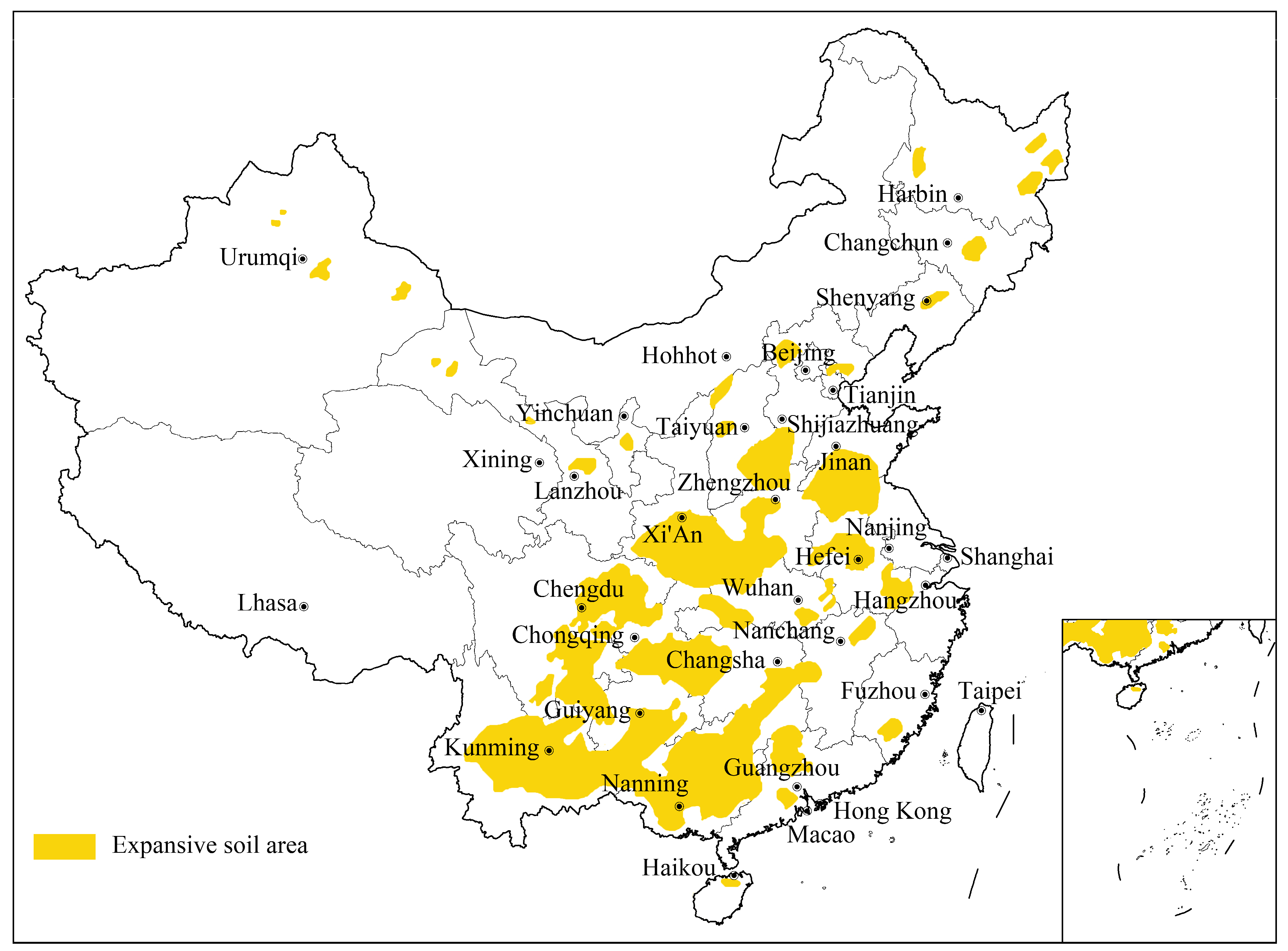

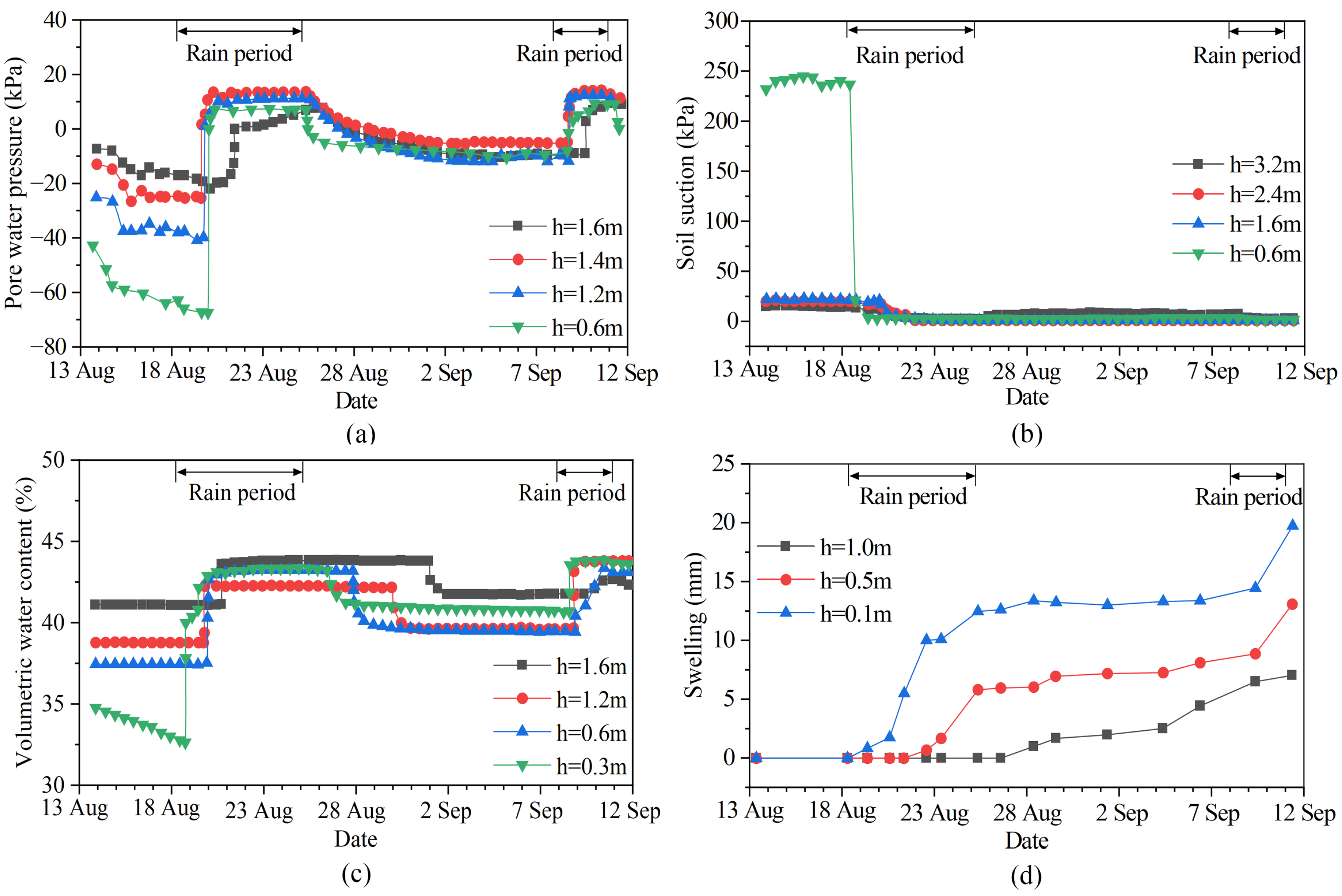
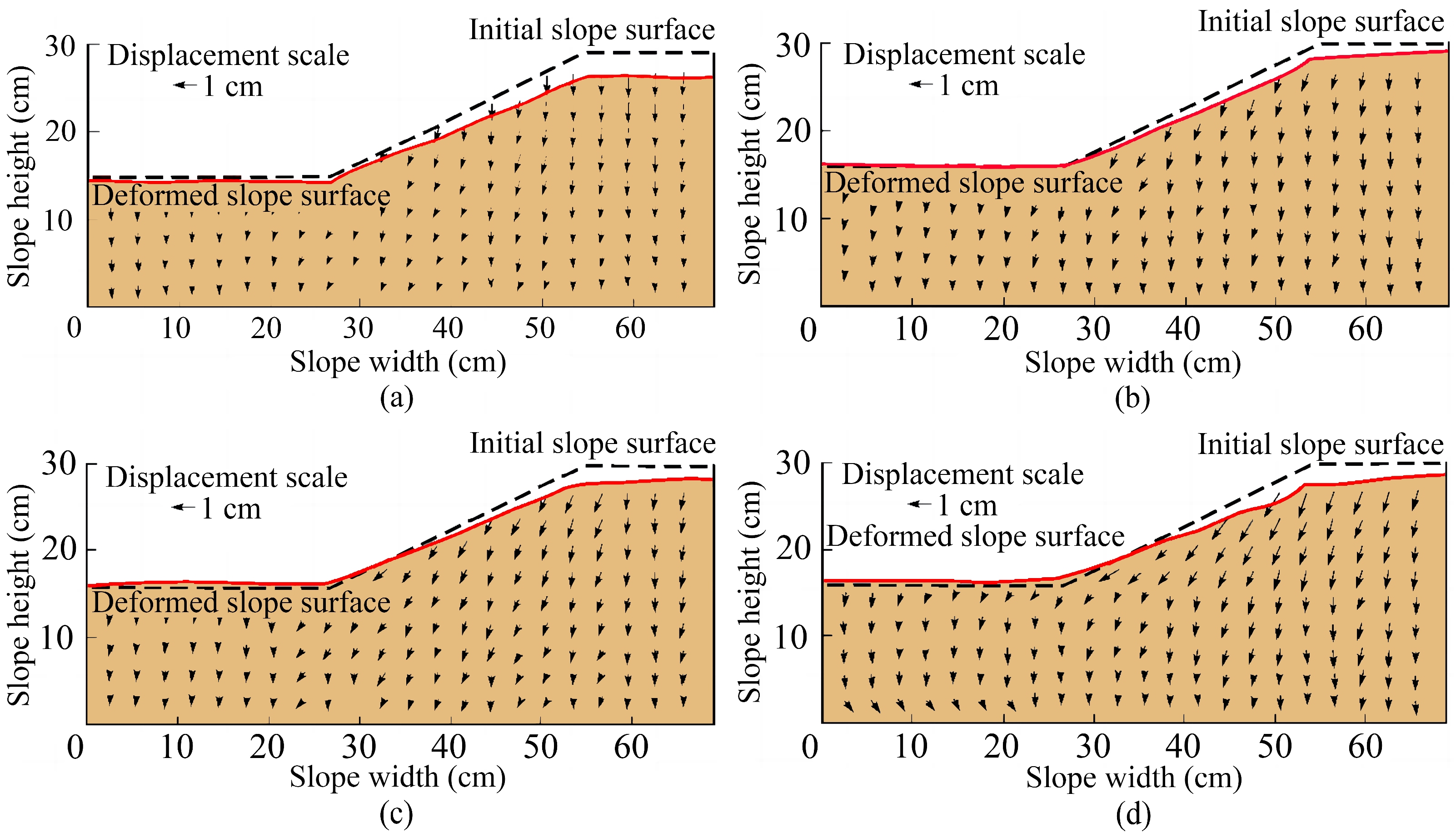

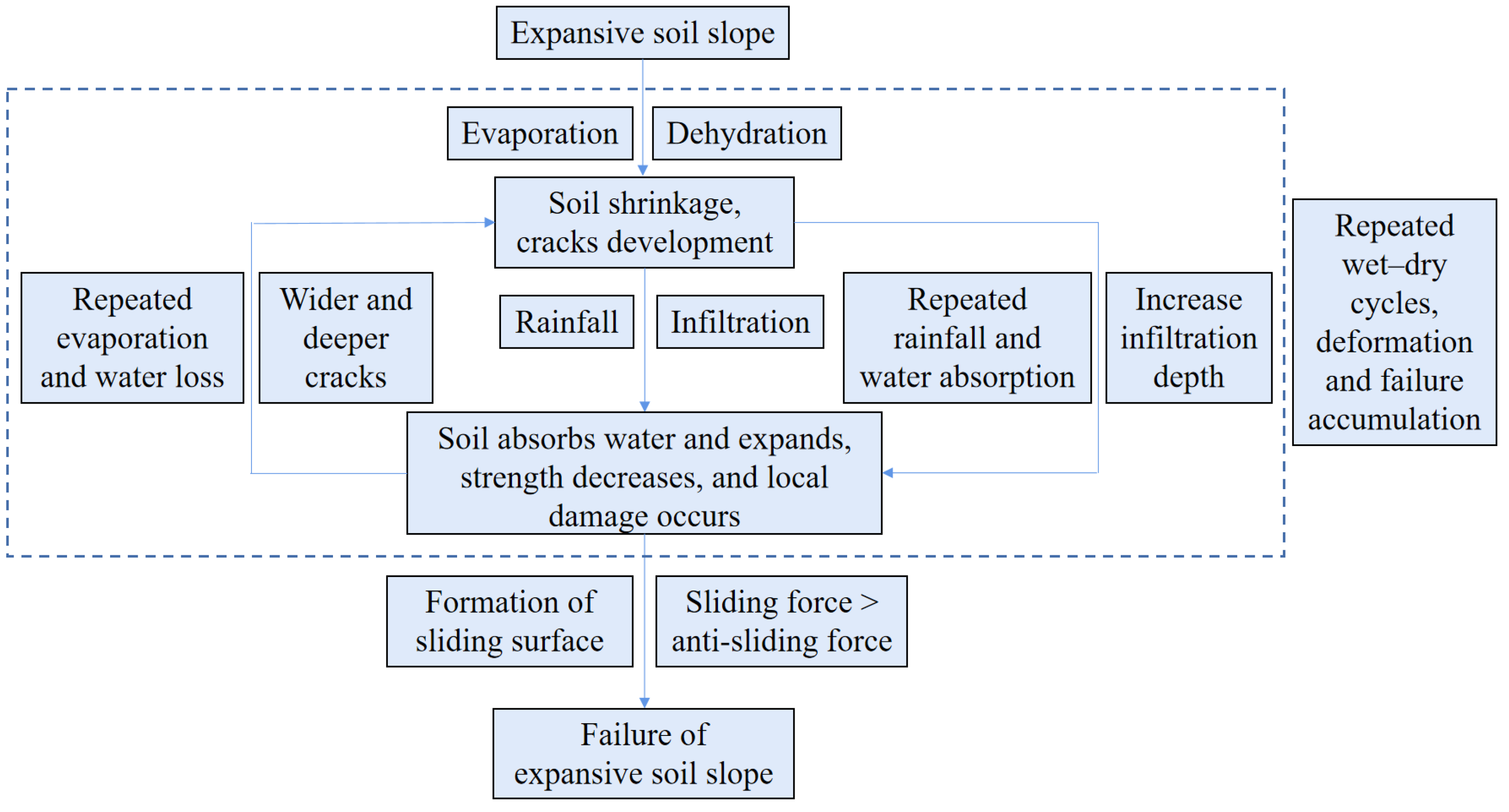
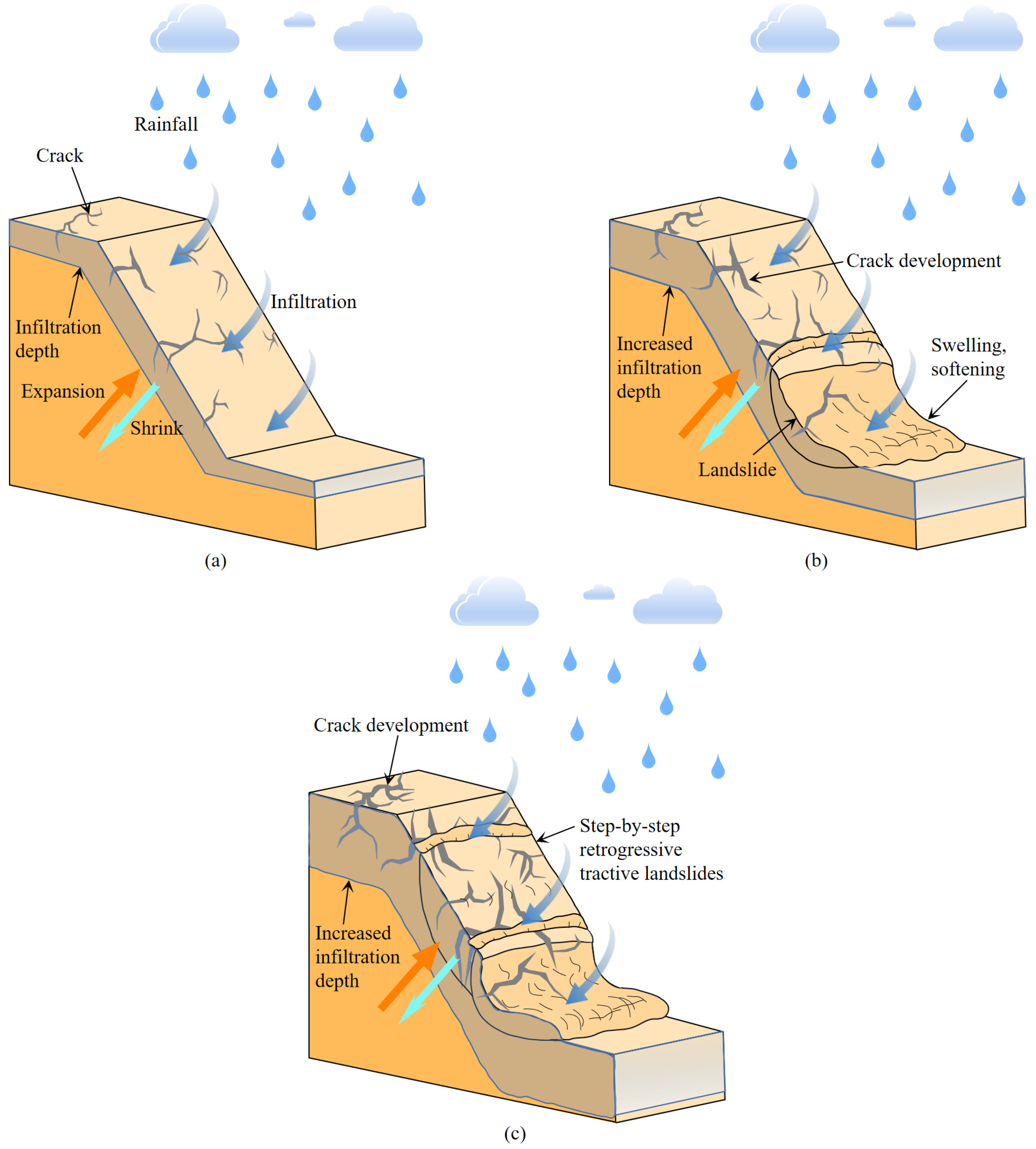
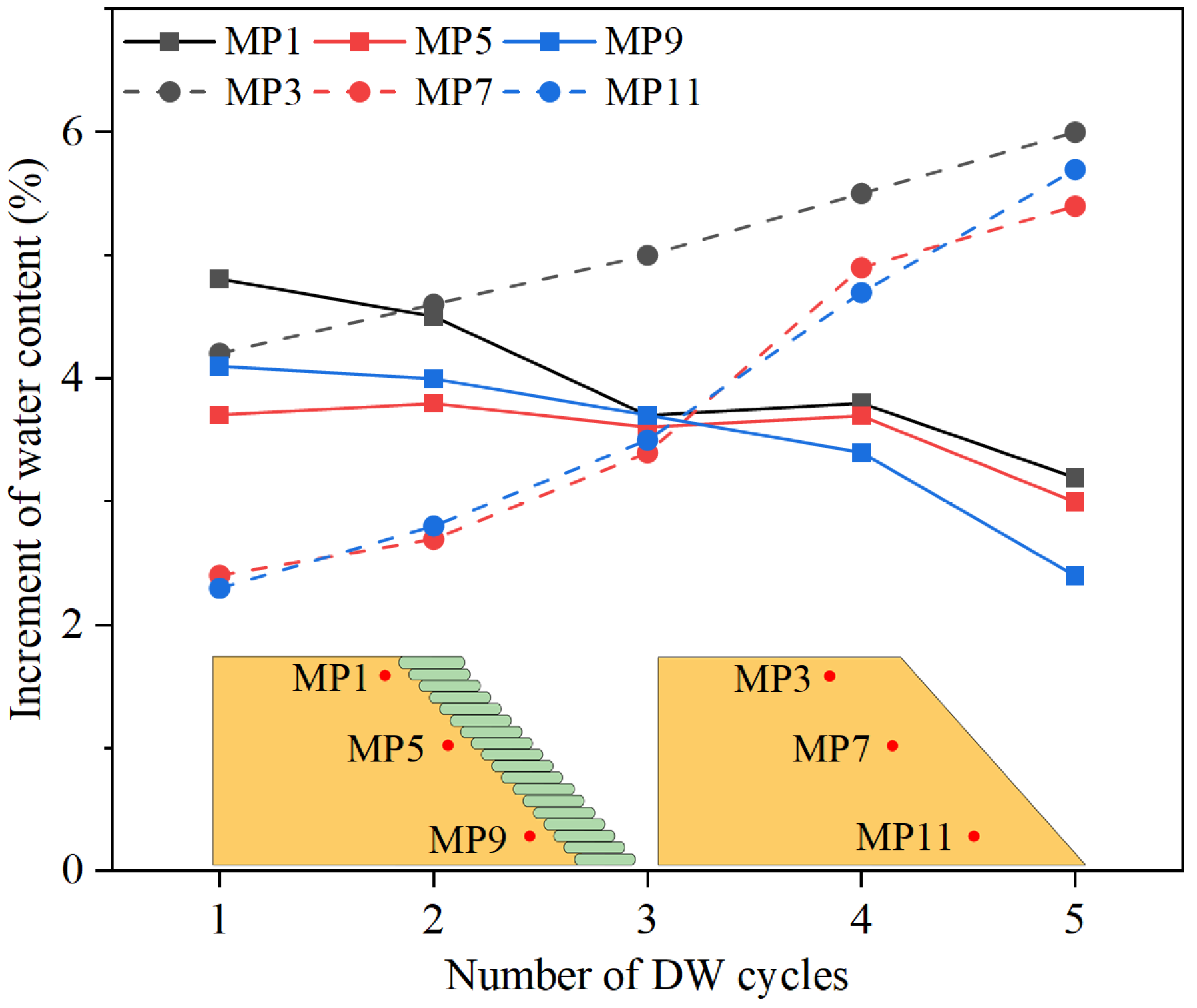
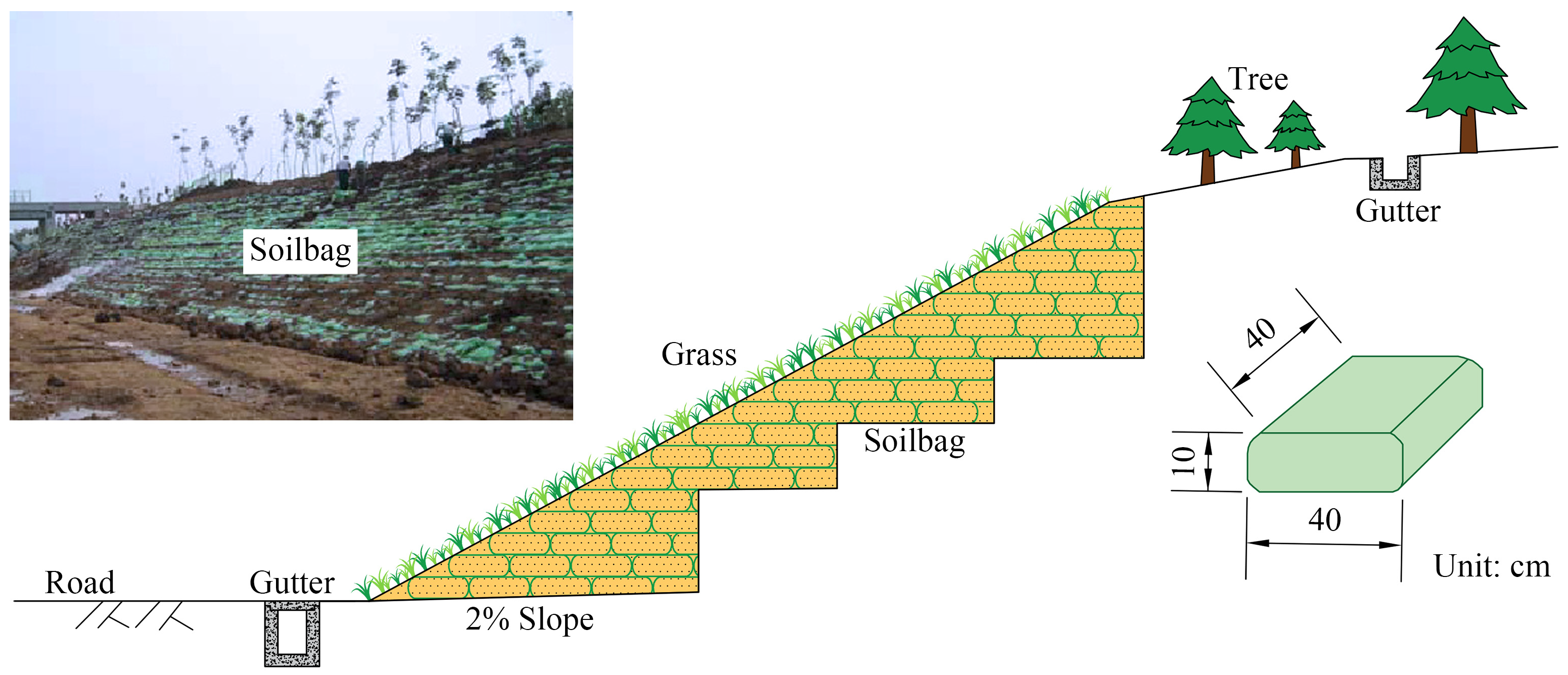
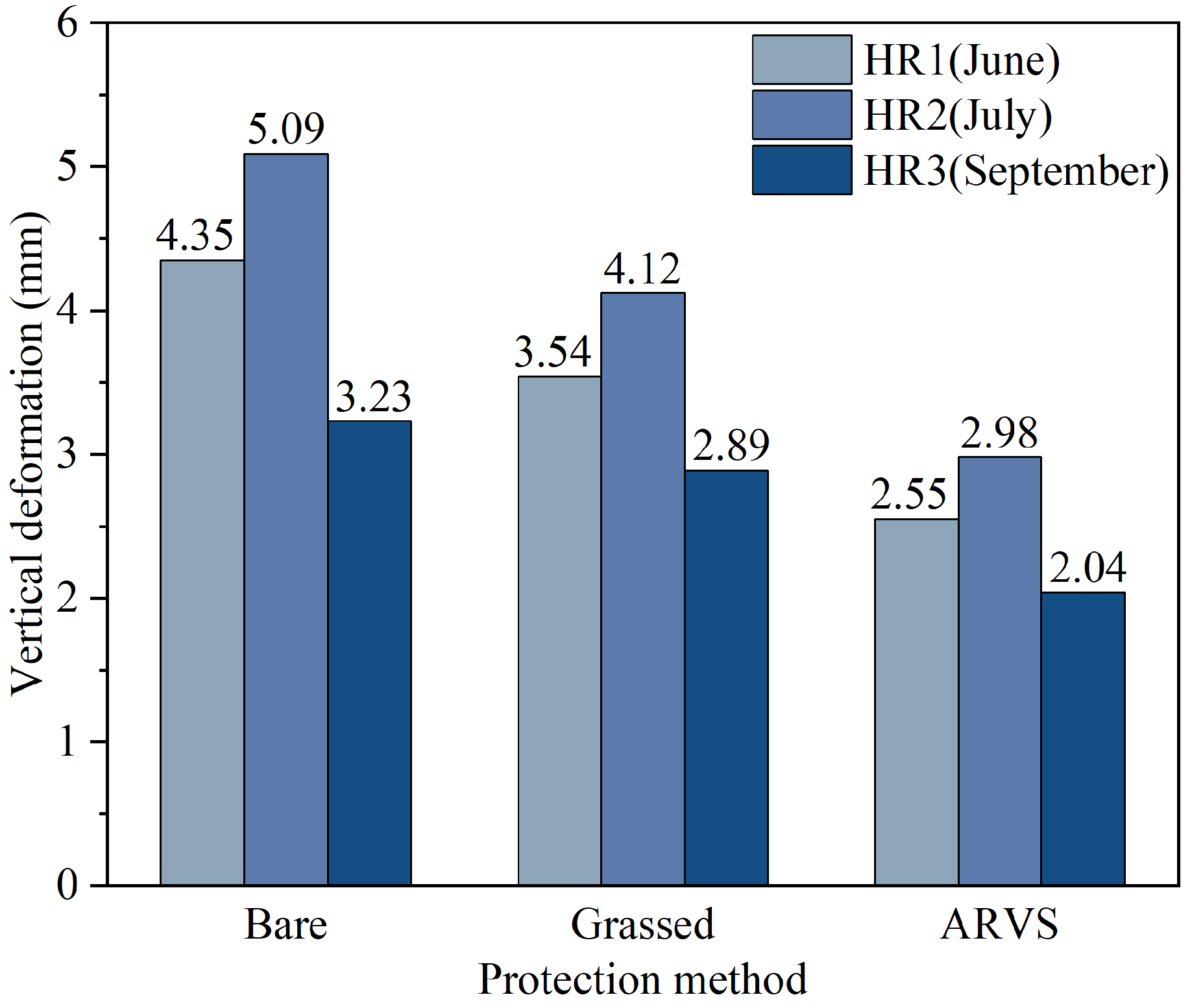

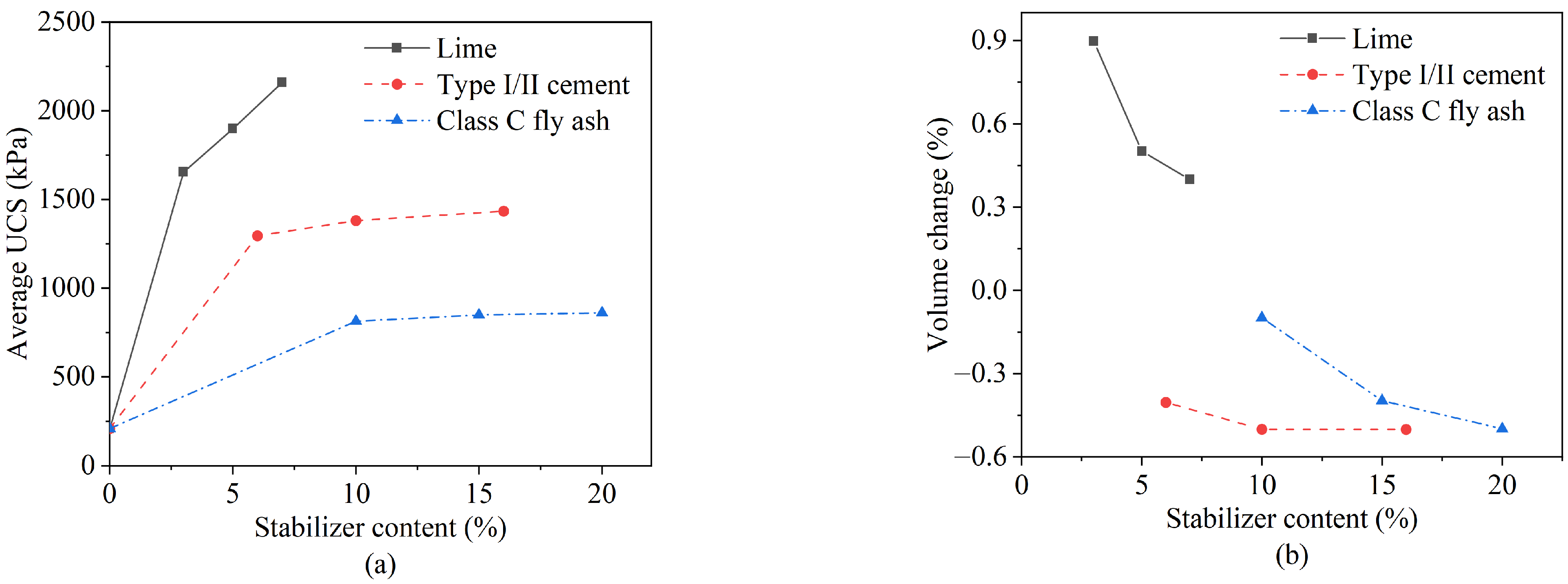
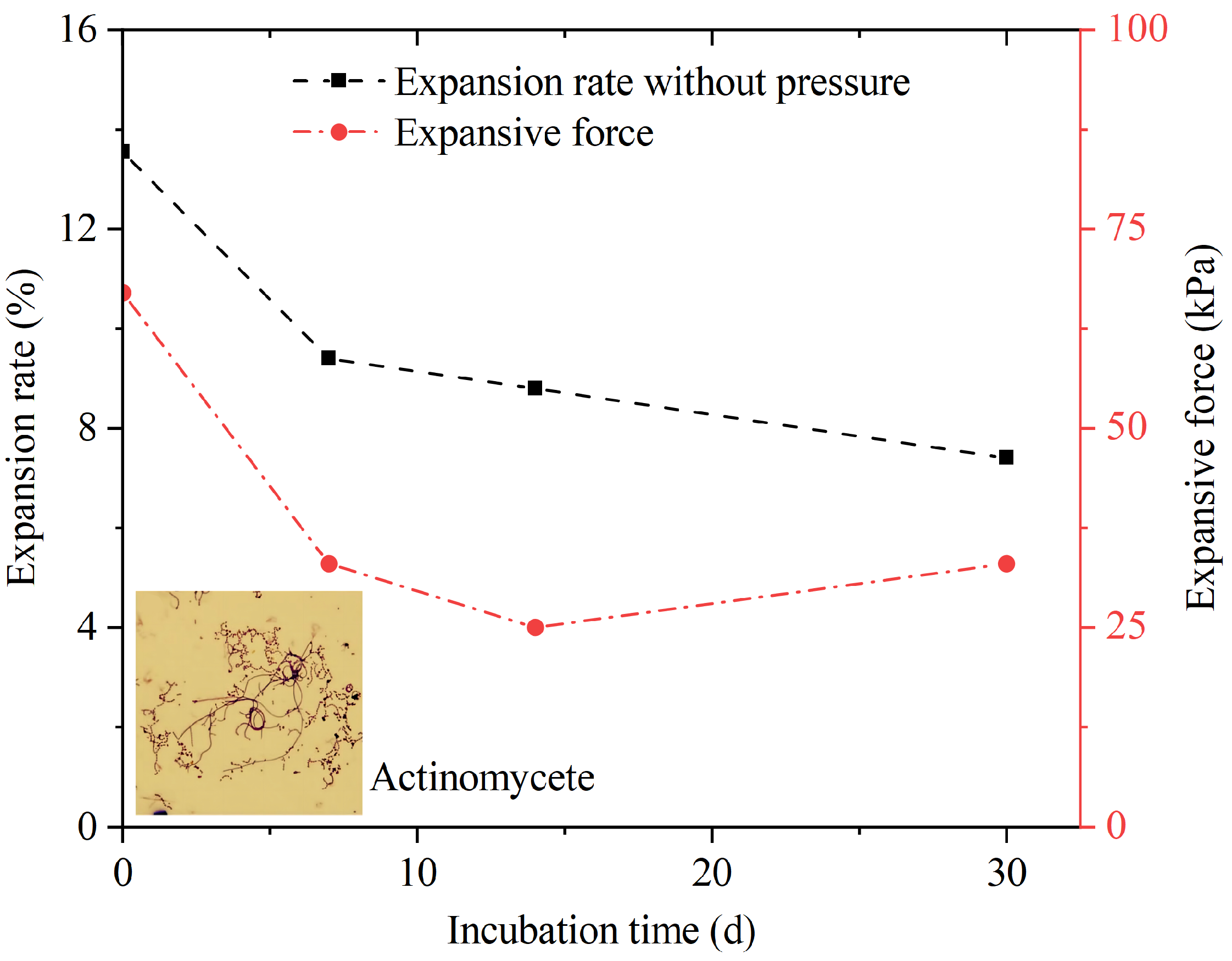

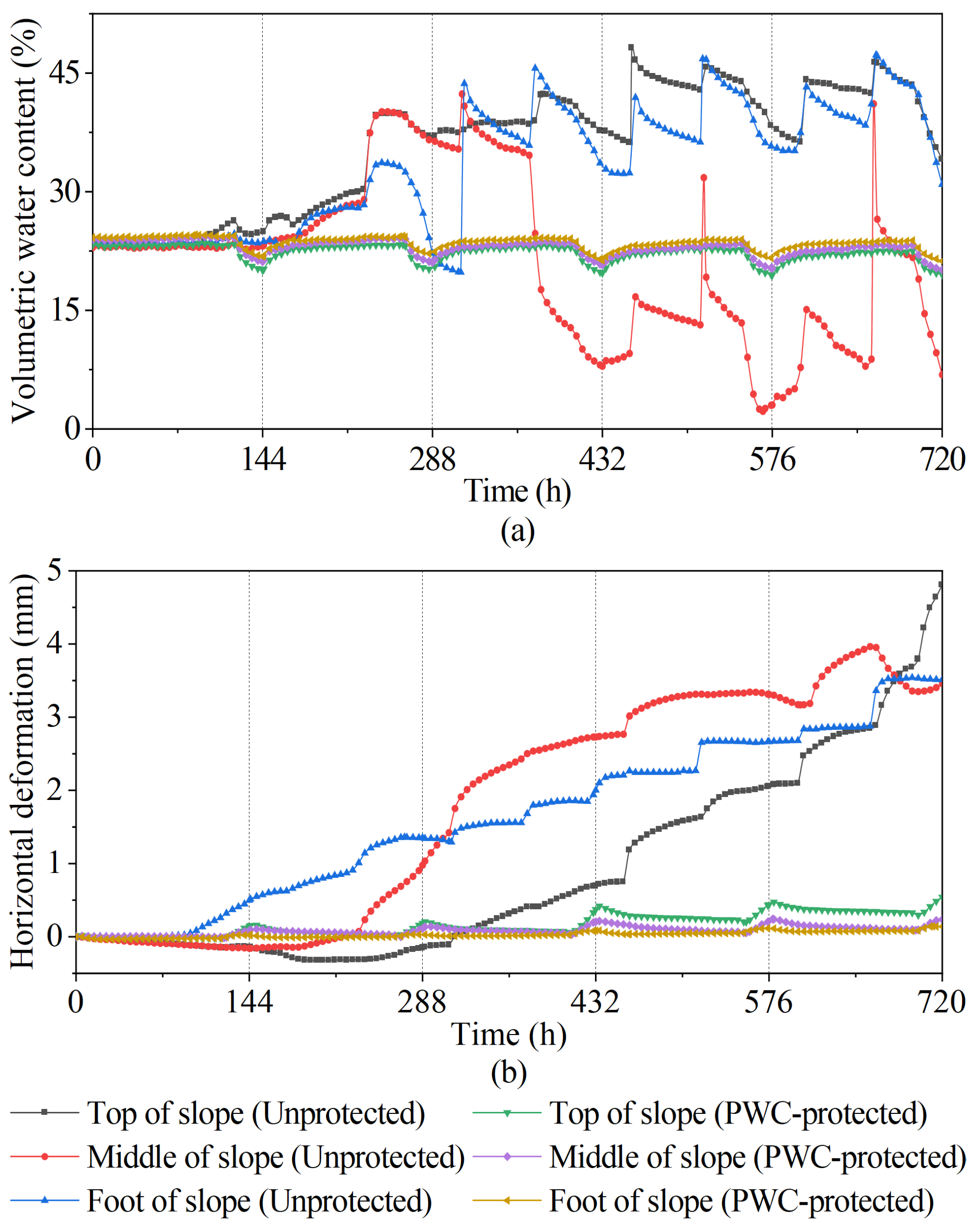
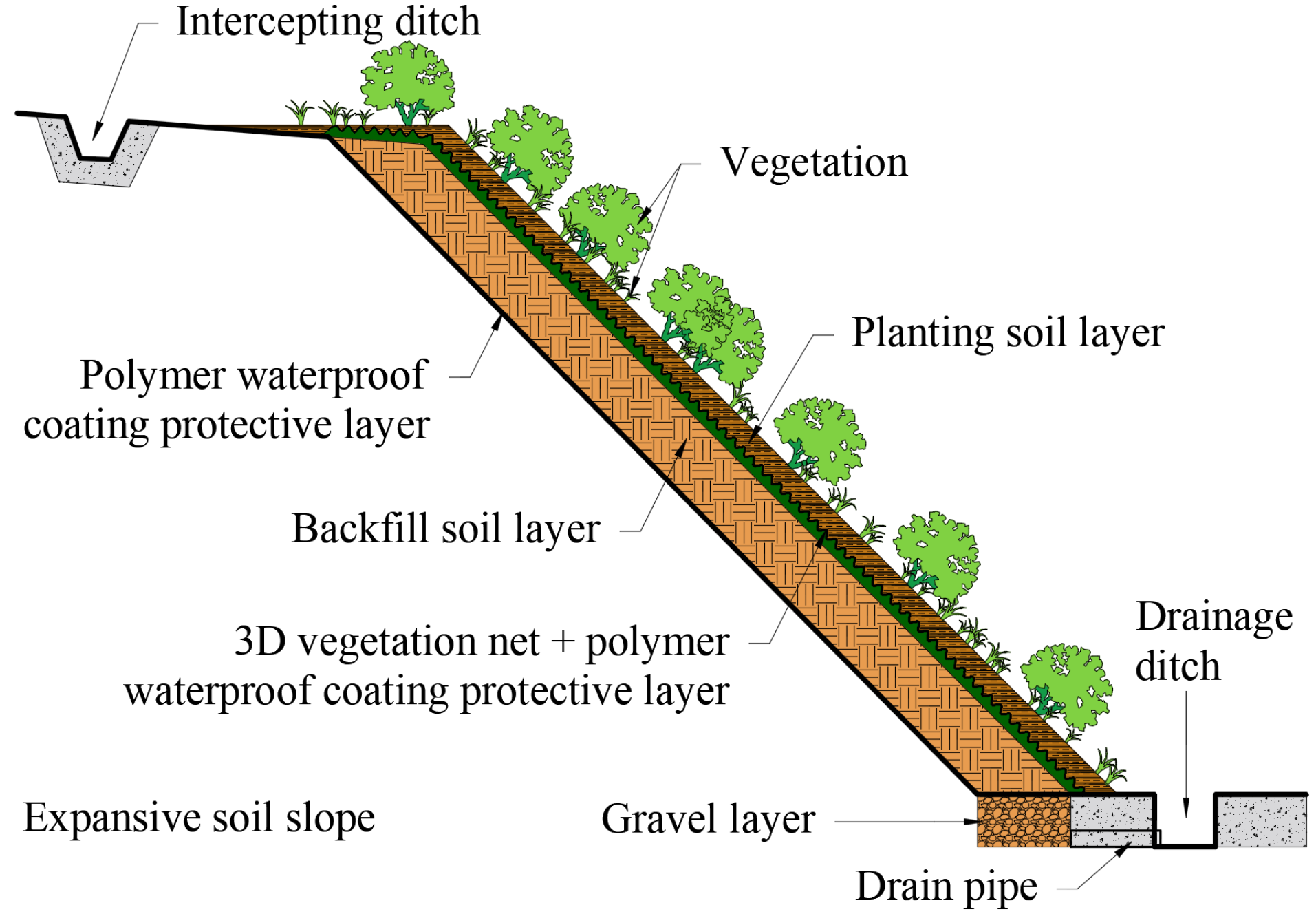
| Research Methods | Advantages | Disadvantages |
|---|---|---|
| Field test | 1. High accuracy and reliability of results. 2. In-situ (undisturbed) test soil. 3. Test environment close to the actual project site conditions. | 1. Long cycle [47]; non-repeatable. 2. High cost [47]. 3. Difficulty in controlling the test conditions, with many constraints. |
| Centrifugal model test | 1. The stress and strain of the model and the prototype are equal, with similar deformation [48,49]. 2. The use of an artificial gravity field can compensate for the loss of stress in the test and reproduce the characteristics of the prototype in a short time [50,51]. 3. The small size of the model saves labor and material resources [52]. 4. Test conditions can be controlled [50]. | 1. High equipment cost. 2. High requirements for material selection. 3. Particle size effect and boundary effect have an impact. |
| Physical model test | 1. Economical and intuitive. 2. Relatively low equipment requirements. 3. Test conditions can be controlled; not subject to the limitations and influence of environmental conditions [53]. | 1. The stress level of the model is much lower than that of the prototype, making it difficult to reproduce the characteristics of the prototype. 2. The test soil is remodeled soil [2]. 3. Boundary effects have an impact. |
| Numerical simulation | 1. Low cost and short time. 2. Easy to operate and repeatable. 3. Can be used in combination with field tests and model tests [53]. 4. It is easy to analyze the stability of expansive soil slopes under different operating conditions by changing the variables [8]. 5. Can be used with access to various parameters of the slope [54]. | 1. Need to make more simplifications and assumptions, resulting in a certain degree of error [55]. 2. Incorrect parameters, conditions, and assumptions can lead to wrong conclusions. |
| Factor Properties | Influencing Factors | Effects on Slopes |
|---|---|---|
| External factors | Rainfall | 1. Soil swelling and softening [62,63]. 2. Pore water pressure increases and effective stress decreases [23,62]. 3. Soil shear strength decreases [23]. 4. Soil self-weight increases, sliding force increases. 5. Slope erosion damage [60]. |
| Wet–dry cycles | 1. Increased crack development destroying the integrity of the soil [74]. 2. Significant changes in soil water content [80]. 3. Generate cumulative deformation [67]. 4. Reduction of the slope safety factor [10,54]. | |
| Human activities | 1. Excavation unloading [17,19]. 2. Loading on the top of the slope, accelerating instability [103,110]. | |
| Internal factors | Cracks | 1. Provision of a direct pathway for rainwater infiltration [59,74]. 2. Reduction in soil strength [57,74]. 3. Tends to the formation of weak or sliding surfaces [56,57]. 4. Acceleration of soil erosion. |
| Swelling–shrinkage | 1. Production of uneven deformation and acceleration of crack development. 2. Causes uneven soil stresses inside the slope; production of stress concentration [53,70]; triggering factor of strength failure. | |
| Soil properties | 1. Increased expansion rate increases the potential for destabilization. 2. Increased hydrophilic mineral content of the soil increases the potential for induced cracking [14]. 3. Decreased soil density and increased degree of weathering increase the likelihood of erosion damage. 4. Increased degree of over-consolidation decreases the safety factor of expansive soil slopes [101]. |
| Protection Principles | Methods and Materials | Effects Analysis | Disadvantages |
|---|---|---|---|
| Waterproofing and water blocking | 1. Geosynthetics reinforcement (e.g., Soilbags [86,112,113], GCL [117,120], geotextiles, geomembranes [119]). 2. Double-layer soil structure protection [121]. 3. Polymer waterproof coating protection [71,80]. 4. Vegetation protection [126]. | 1. Effectively prevent rainwater infiltration and maintain soil moisture stability [71,80,117,120]. 2. Reducing water evaporation, crack development, and soil erosion on slopes [71,80]. 3. Most of the methods can obtain ideal slope stabilization effects with short-time maintenance. 4. Some methods apply to the reinforcement of the underwater portion of expansive soil channel slopes [118]. | 1. Complicated construction process and high cost. 2. Difficult to guarantee the weather resistance and durability of geosynthetics. 3. Poor initial stress resistance of vegetation. |
| Limitation of swelling–shrinkage deformation | 1. Flexible limitation method (e.g., Geogrids [128], geo-cells [130], soilbags [115], ARVS [131,132]). 2. Rigid limitation method (e.g., anchors [137,138], soil nails [104], retaining walls [140,141], anti-slide piles). | 1. Effectively reinforcing the soil of the slope and suppressing swelling–shrinkage deformation [130]. 2. Flexible materials allow a certain deformation of the slope [115,131,132]. 3. The combination of flexible and rigid limitation methods can better improve slope stability [143]. | 1. Rigid structures are prone to structural damage. 2. Difficulty in ensuring the weather resistance and durability of geosynthetics. 3. Difficult to inhibit rainwater infiltration and soil erosion effectively. |
| Crack inhibition and strength enhancement | 1. Industrial waste material modification (e.g., lime [93,144,154], cement [148,152], fly ash [149,152,155], marble dust [150], dolomite). 2. Agricultural waste material modification (e.g., bagasse fiber [163], bagasse ash [157], rice husk [161], biochar [159]). 3. Biological modification (e.g., microbial [176,179], bio-enzymes [180,181,182]). 4. Mixed modification of various materials [160,161,162,163,164]. | 1. Various types of modified materials are available and waste materials can be effectively utilized [149,152,155]. 2. It can improve the strength and seepage resistance, reduce the expansion potential of expansive soil, and improve the adverse properties of expansive soil [50,144,145,146,147,148,149,150,151,159]. 3. Specific materials can be mixed to treat expansive soil with better modification effects [152]. 4. Biological modification is environmentally friendly [176,179,180,181,182]. | 1. The mixing method is troublesome and pollutes the soil environment. 2. Most of the modifications require long-term maintenance [144,154]. 3. It is necessary to add expansive soil in a reasonable amount to achieve the best balance between improvement effect and economy. 4. It is difficult to guarantee the long-term effectiveness of the biomodification method. |
Disclaimer/Publisher’s Note: The statements, opinions and data contained in all publications are solely those of the individual author(s) and contributor(s) and not of MDPI and/or the editor(s). MDPI and/or the editor(s) disclaim responsibility for any injury to people or property resulting from any ideas, methods, instructions or products referred to in the content. |
© 2024 by the authors. Licensee MDPI, Basel, Switzerland. This article is an open access article distributed under the terms and conditions of the Creative Commons Attribution (CC BY) license (https://creativecommons.org/licenses/by/4.0/).
Share and Cite
Luo, P.; Ma, M. Failure Mechanisms and Protection Measures for Expansive Soil Slopes: A Review. Sustainability 2024, 16, 5127. https://doi.org/10.3390/su16125127
Luo P, Ma M. Failure Mechanisms and Protection Measures for Expansive Soil Slopes: A Review. Sustainability. 2024; 16(12):5127. https://doi.org/10.3390/su16125127
Chicago/Turabian StyleLuo, Peng, and Min Ma. 2024. "Failure Mechanisms and Protection Measures for Expansive Soil Slopes: A Review" Sustainability 16, no. 12: 5127. https://doi.org/10.3390/su16125127
APA StyleLuo, P., & Ma, M. (2024). Failure Mechanisms and Protection Measures for Expansive Soil Slopes: A Review. Sustainability, 16(12), 5127. https://doi.org/10.3390/su16125127






